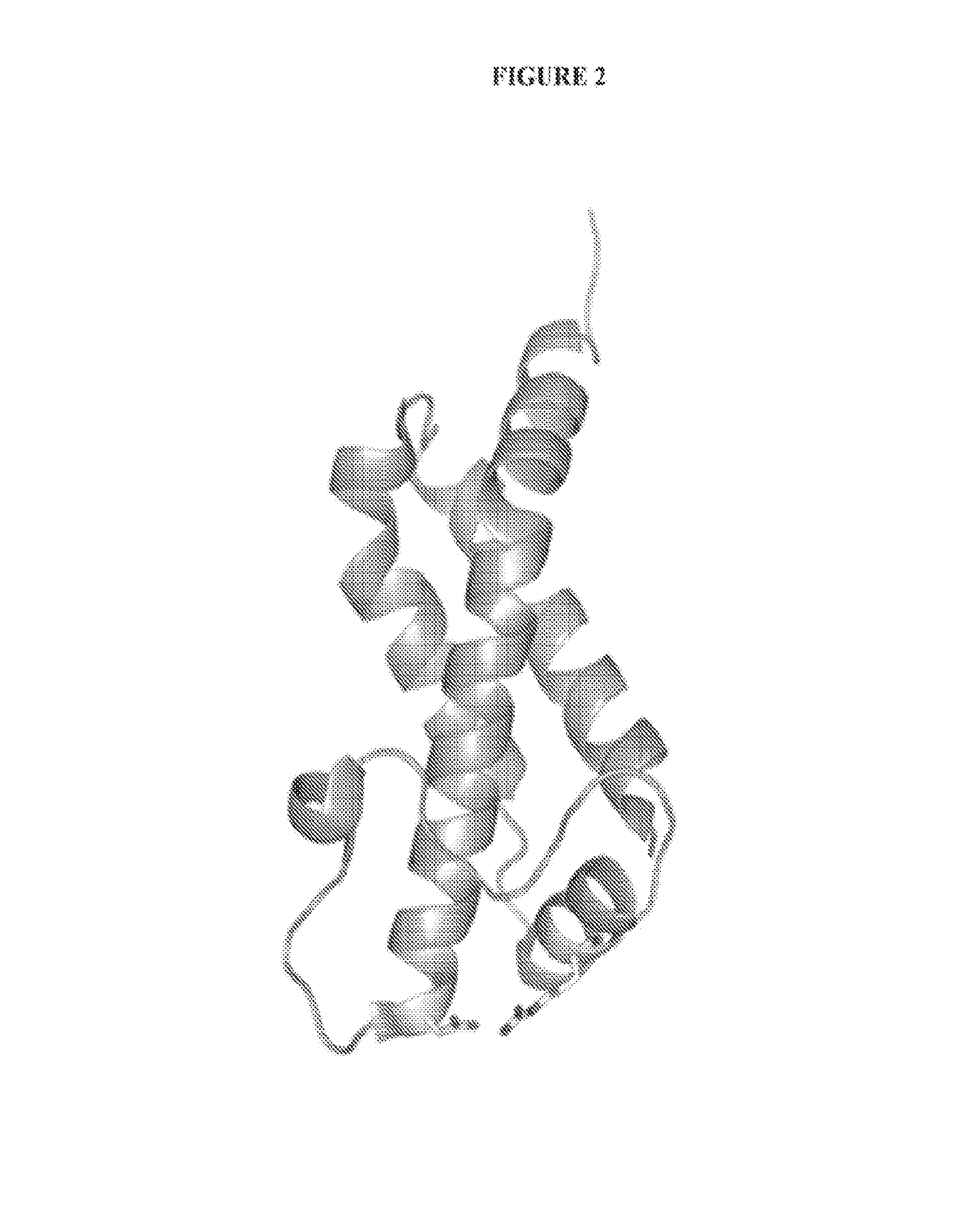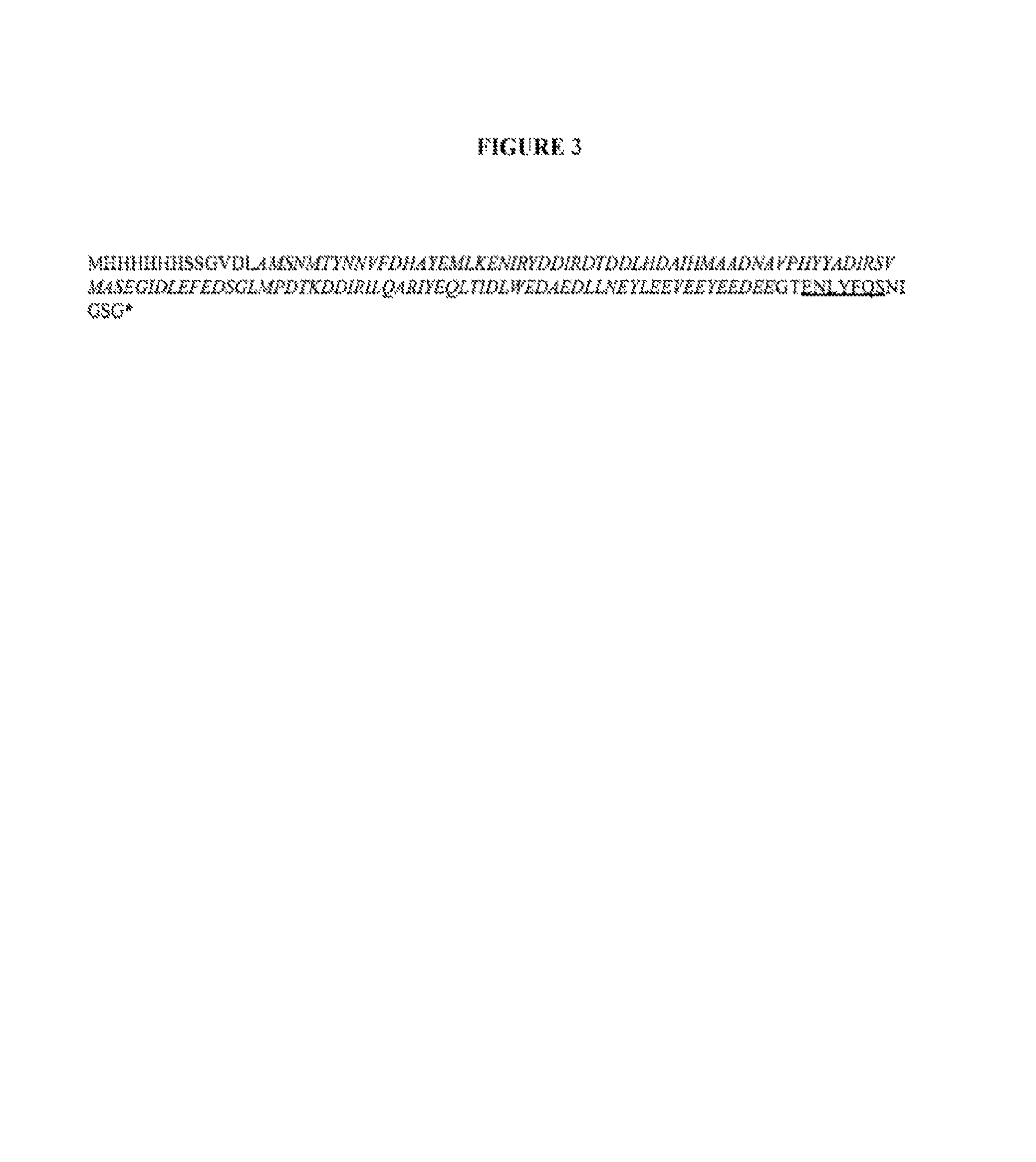Protein purification tags and uses thereof
a technology of protein purification and tags, applied in the field of fusion proteins, can solve problems such as interference with downstream applications such as nmr or crystallization
- Summary
- Abstract
- Description
- Claims
- Application Information
AI Technical Summary
Benefits of technology
Problems solved by technology
Method used
Image
Examples
example 1
A. Methods and Materials
[0130]Construction and cloning of mocr. A synthetic sequence of the ocr gene was created to yield oligos with minimal dimerization potential and self-annealing. The purpose of the silent mutations contained in the synthetic sequence was to improve the efficiency of the synthetic gene construction. This sequence also incorporated mutations that change the amino acid sequence. Codon 53 has been changed from TTT to CGT and codon 77 has been changed from GTA to GAC (FIG. 1A; SEQ ID NO:3). These codon changes gave rise to the following amino acid changes: F53R and V77D. The amino acid sequence of Mocr is shown in FIG. 1B (SEQ ID NO:4).
[0131]The gene was then constructed through a combination of sequential oligo pair annealing and ligation and PCR. For sequential oligo pair annealing and ligation, the oligos were resuspended in water to 20 μM. Each oligo was then phosphorylated in a 20 μl reaction containing 2 μl ATP (10 mM), 2 μl 10× ligation buffer (NEB), 12.5 μl...
example 2
[0165]Variants of the Mocr gene were designed and tested. These variants give rise to charged proteins with 1) a more acidic pI than Mocr, or 2) a basic pI, or 3) an uncharged protein in which serine has been substituted for the native amino acids (FIG. 14). A commercial vendor synthesized these gene sequences and the synthesized sequences were cloned into pMCSG7 (see, e.g., Example 1).
[0166]Expression trials were carried with these genes alone in absence of fusion to a partner protein sequence using methods described in Example 1. All three versions of the Mocr protein were produced in E. coli. The acidic version was found only in the soluble fraction. The basic version was partitioned between the soluble and insoluble fractions of the cell. The serine rich version was found only in the insoluble fraction of the cell.
example 3
[0167]In some embodiments, additions, deletions, or substitutions are made to Mocr-encoding nucleic acid sequences to alter the linker region between the Mocr protein tag and the passenger protein with the intent of providing amino acid linker sequence with rigid structure. While the present invention is not limited to any particular mechanism, and an understanding of the mechanism is not necessary to practice the present invention, it is contemplated that inclusion of such rigid linker structure between the Mocr protein tag and the passenger protein facilitates crystallization of the resulting fusion protein. The ligation-independent cloning region in the original Mocr construct and the carboxyl terminal unstructured region identified in the Ocr structure is removed (FIG. 15). The last two amino acids in the final alpha helix of Ocr are leucine and glutamate. The coding sequence in the gene for these amino acids is changed to yield an XhoI restriction site. A passenger protein codi...
PUM
| Property | Measurement | Unit |
|---|---|---|
| OD | aaaaa | aaaaa |
| temperature | aaaaa | aaaaa |
| pH | aaaaa | aaaaa |
Abstract
Description
Claims
Application Information
 Login to View More
Login to View More - R&D
- Intellectual Property
- Life Sciences
- Materials
- Tech Scout
- Unparalleled Data Quality
- Higher Quality Content
- 60% Fewer Hallucinations
Browse by: Latest US Patents, China's latest patents, Technical Efficacy Thesaurus, Application Domain, Technology Topic, Popular Technical Reports.
© 2025 PatSnap. All rights reserved.Legal|Privacy policy|Modern Slavery Act Transparency Statement|Sitemap|About US| Contact US: help@patsnap.com



